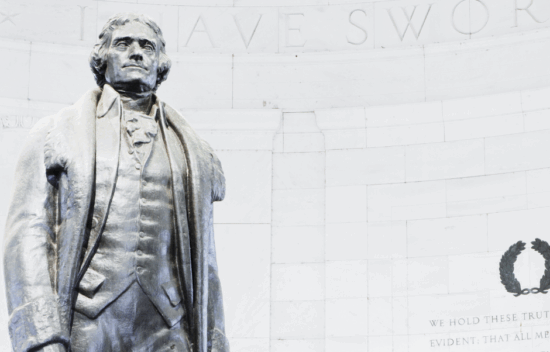
Decisions in the Early Republic
Guiding Question
- How did the Constitution influence decisions in the Early Republic?
Objectives
- Students will analyze key events from 1789-1815, tracing their causes and effects to understand how decisions shaped the Early Republic.
- Students will use specific historical events to make cause-and-effect analysis concrete.
- Students will connect events to the bigger historical picture.
- Students will engage in critical thinking and historical reasoning.
Student Resources:
Teacher Resources:
- A few dominoes (3-10 is sufficient)
- Chart paper
- Sticky notes
Facilitation Notes
- This lesson supports cause and effect understanding using the Early Republic Interactive Timeline.
Anticipate
- Glossary terms: terms used in this lesson for pre-teach opportunities or vocabulary support.
- Neutrality, Proclamation, Cause, Effect, Rebellion, Sentiment, Opposition, Federalists, Democratic-Republicans, Sedition, Embargo, Impressment, Nationalism, Smuggling
- Before beginning the lesson, it may be necessary to pre-teach vocabulary that students will encounter.
- Consider using one of the activities from our Teacher Vocabulary Activity Guide to pre-teach vocabulary from the list of glossary terms.
Engage
- Glossary terms used in this part of the lesson: neutrality, proclamation, cause, effect
- Transition: Create a small line of standing dominoes in a place that all students can see from their desks.
Domino Decisions Introduction and Demonstration
- Ask students: “What happens when a new country struggles to define its government, deal with foreign nations, or handle internal disagreements?”
- Show a simple chain of causes and effects on the board (e.g., Washington’s Neutrality Proclamation → British and French reactions → Challenges to U.S. shipping).
- Explain that today, they’ll trace how early decisions created ripple effects.
- Topple the line of dominoes theatrically, to illustrate how one action can set a ripple effect in motion.
Explore
- Glossary terms used in this part of the lesson: rebellion, sentiment, opposition, Federalists, Democratic-Republicans, sedition, embargo, impressment, nationalism, smuggling
Timeline Investigation (Small Groups by Event)
- Transition: Assign students to small groups of 2-4 students.
- Each group gets one key event from the timeline. Their task is to determine:
- What caused this event?
- What were the immediate and long-term effects?
- How did this event connect to others in the Early Republic?
Events for Groups:
- Washington’s Neutrality Proclamation (1793)
- Cause: The French Revolution leads to war in Europe.
- Effects: Britain and France challenge U.S. neutrality by attempting to have it become involved, leading to events like negotiating the Jay Treaty and the Quasi-War.
- Whiskey Rebellion (1794)
- Cause: A federal tax on whiskey angers frontier farmers.
- Effects: Washington enforces federal authority by putting down the rebellion and enforcing the tax, proving the strength of the Constitution but sparking debate over federal power.
- XYZ Affair (1797-1798)
- Cause: France demands bribes from U.S. diplomats.
- Effects: Anti-French sentiment rises, the Quasi-War begins, and the U.S. expands its navy to strengthen national defense.
- Alien and Sedition Acts (1798)
- Cause: Fear of French influence and internal opposition to Federalists.
- Effects: Limits on free speech, backlash from states (Kentucky & Virginia Resolutions), contributes to Jefferson’s election.
- Louisiana Purchase (1803)
- Cause: Napoleon needs money for European wars, U.S. wants to expand.
- Effects: Doubles U.S. territory, sparks debate over constitutional authority and executive power, increases conflict with Native Americans.
- Embargo Act (1807)
- Cause: British impressment of American sailors and interference with trade.
- Effects: U.S. economy suffers, smuggling increases, contributes to War of 1812.
- War of 1812 (1812-1815)
- Cause: British impressment, trade restrictions, Native American conflicts.
- Effects: National unity increases, Native alliances weaken, U.S. manufacturing grows, Federalist Party declines.
- Each group shares findings with the class, and a large cause-effect web is built on the board.
Ripple Effects Discussion
- Class discussion: Which events had the biggest impact?
- Introduce short-term vs. long-term effects:
- Short-term: Embargo Act damages economy.
- Long-term: Louisiana Purchase leads to expansion debates over slavery.
- Introduce intended vs. unintended consequences:
- Example: Alien & Sedition Acts → Federalists wanted control, but backlash helped Jefferson win in 1800.
- Introduce short-term vs. long-term effects:
Assess
Cause-Effect Chain Mapping
- Each student picks one event and maps out three layers of effects in concentric circles:
- Immediate Effect (What happened right away?)
- Secondary Effect (What changed later?)
- Long-Term Impact (How did this shape the future of the U.S.?)
- Display maps around the room for a gallery walk where students analyze patterns.
Reflect and Extend
Cause and Effect Gallery Walk
- Each event is posted on the wall with room to post sticky notes around it.
- Students move around in groups of two and use the timeline to add:
- One new cause (What earlier event led to this?)
- One new effect (How did this shape later history?)
- Exit ticket: Which event caused the biggest chain reaction?